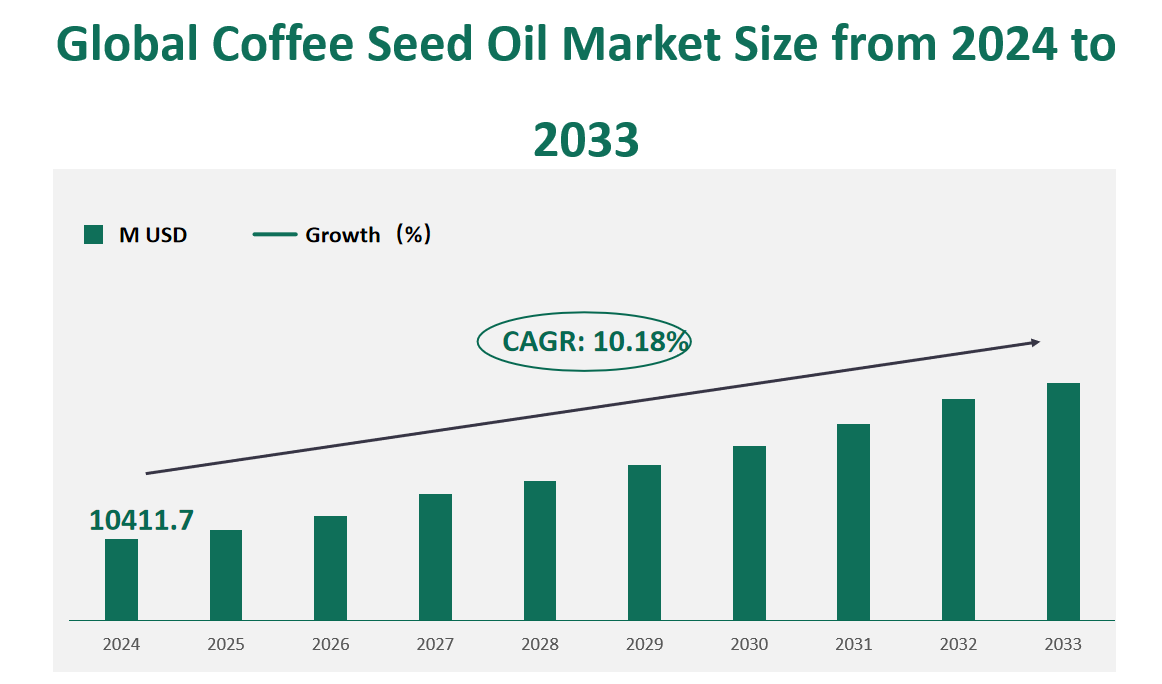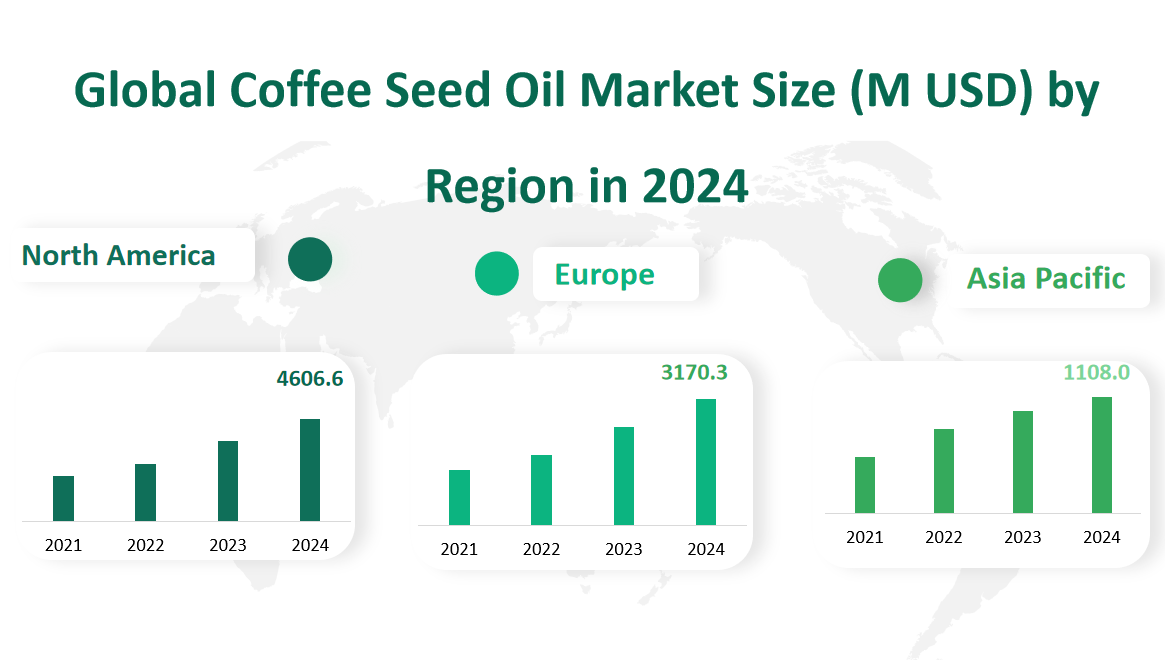1 Global Coffee Seed Oil Market Insight Analysis
The global Coffee Seed Oil Market will have a CAGR of 10.18% from 2024 to 2033, and the total market value will reach US$10,411.7 million in 2024.
Coffee Seed Oil Market is obtained from the roasted or green coffee beans and can be either cold pressed or released with the help of solvents. Coffee seed oil contains several compounds that may benefit the skin, scalp, and hair, such as vitamin E, phytosterols, antioxidants, and essential fatty acids. It can be used in various cosmetic formulations as well as essential oils for aromatherapy, etc.
Figure Global Coffee Seed Oil Market Size (M USD) and CAGR (2024-2033)

2 Coffee Seed Oil Market Growth Drivers and Restraints
The coffee seed oil market is experiencing a period of significant growth, with a multitude of factors contributing to this expansion. One of the key drivers is the increasing demand for natural ingredients in the cosmetics and personal care sectors. Consumers are becoming more health-conscious and are seeking out products with natural and sustainable origins, which positions coffee seed oil as an attractive option due to its rich antioxidant content and potential health benefits. The oil’s anti-inflammatory properties, its ability to protect the skin from free radicals, and its role in promoting collagen production are particularly appealing to consumers.
Another driver is the growing interest in sustainable and circular economy practices. Companies like Kaffe Bueno are leading the way by recycling coffee grounds and developing coffee bio-refineries, which not only reduces waste but also taps into the eco-friendly trend that is gaining momentum globally. This approach aligns with the increasing consumer demand for products that are not only good for personal health but also for the environment.
However, the market is not without its challenges. One of the primary constraints is the volatility in raw material prices. Coffee beans, the key input for coffee seed oil, are subject to market fluctuations that can impact profitability. The COVID-19 pandemic has further exacerbated this issue by disrupting supply chains and increasing logistical costs, which in turn affects the availability and pricing of coffee beans. Additionally, extreme weather events, such as droughts, can significantly reduce coffee bean production, leading to supply shortages and price increases.
The market is also constrained by the relatively high production costs and the need for advanced extraction technologies. While methods like cold pressing and solvent extraction are used, they each have their drawbacks, such as high residual oil rates and potential environmental impacts. There is a need for more efficient and sustainable extraction methods that can reduce costs and minimize environmental harm.
3 Technological Innovations and Mergers in the Coffee Seed Oil Market
Innovations in the coffee seed oil market are centered around improving the extraction process and enhancing the quality of the final product. Companies are investing in research and development to find more efficient ways to extract oil from coffee beans, focusing on methods that preserve the nutritional and aromatic properties of the oil. The use of supercritical CO2 extraction, for example, is being explored for its ability to yield high-quality oil without the use of harmful solvents.
Mergers and acquisitions are also shaping the market landscape, with companies looking to expand their footprint and strengthen their market position. Hallstar’s acquisition of a North Carolina esters facility from Lanxess is a strategic move to increase manufacturing capacity and product offerings. Such acquisitions not only enhance the product portfolio but also improve supply chain efficiency and customer service capabilities.
Furthermore, companies are exploring new applications for coffee seed oil beyond traditional uses in food and beverages. The personal care and cosmetics industries are seeing an influx of products featuring coffee seed oil for its rejuvenating and protective properties. This innovation in product development is driving market growth and creating new opportunities for coffee seed oil producers.
In summary, the coffee seed oil market is dynamic, with growth being propelled by health and sustainability trends, while also facing challenges in raw material pricing and production efficiency. Innovations in extraction technologies and strategic corporate moves are key to overcoming these hurdles and capitalizing on the market’s potential.
4 Global Coffee Seed Oil Market Size by Type
The global coffee seed oil market is categorized into two primary types: Green Coffee Seed Oil and Roasted Coffee Seed Oil, each with its unique characteristics and applications. According to the forecast for 2024, these two types are expected to contribute significantly to the overall market revenue.
Green Coffee Seed Oil, derived from raw coffee beans, is anticipated to hold a substantial market share in 2024. This type of oil is valued for its light brown to yellow color and its nearly odorless nature, making it ideal for a wide range of cosmetic formulations. The 2024 forecast suggests that Green Coffee Seed Oil will generate revenues of $2980.9 million USD, capturing a market share of approximately 28.63%. The growth of this segment can be attributed to its use in premium skincare products and its association with natural and organic offerings, which are increasingly sought after by consumers.
On the other hand, Roasted Coffee Seed Oil, obtained from roasted beans, is expected to dominate the market in terms of revenue. With its distinct coffee aroma and color ranging from green to dark brown, this oil is favored in applications where the characteristic coffee scent is desired. The market revenue for Roasted Coffee Seed Oil in 2024 is projected to reach $7430.8 million USD, securing a market share of around 71.37%. This type of oil is not only used in cosmetics but also in food and beverages, personal care products, and aromatherapy, owing to its rich flavor and fragrance.
The differing market shares of these two types can be attributed to their distinct uses and consumer preferences. Roasted Coffee Seed Oil, with its robust coffee flavor, finds broader application in various industries, while Green Coffee Seed Oil caters to a niche market that prefers its milder profile and odorless characteristic.
In summary, the global coffee seed oil market in 2024 is expected to be led by Roasted Coffee Seed Oil in terms of revenue, with Green Coffee Seed Oil maintaining a significant, though comparatively smaller, share. The market’s segmentation by type highlights the diversity of applications and consumer preferences, with each type fulfilling specific needs within the cosmetics, personal care, and food and beverage industries. As the market continues to evolve, the demand for both types of coffee seed oil is expected to grow, driven by their unique properties and the increasing recognition of their benefits.
Table Global Coffee Seed Oil Market Size and Share by Type in 2024
|
Type |
Market Size (M USD) 2024 |
Market Share 2024 |
|---|---|---|
|
Green Coffee Seed Oil |
2980.9 |
28.63% |
|
Roasted Coffee Seed Oil |
7430.8 |
71.37% |
5 Global Coffee Seed Oil Market Size by Application
The global coffee seed oil market is anticipated to showcase a diversified landscape in terms of applications, with each segment contributing significantly to the overall market revenue in 2024. The applications are segmented into Food and Beverages, Cosmetics, Personal Care, and Others.
In the Food and Beverages sector, coffee seed oil is expected to generate a revenue of $517.3 million USD, holding a market share of approximately 4.97%. This segment benefits from the oil’s unique flavor profile, which adds a distinct taste to various food items and beverages.
The Cosmetics application is projected to be the most dominant, with a forecasted revenue of $6170.1 million USD, capturing a substantial market share of 59.26%. Coffee seed oil’s rich antioxidant properties and its potential to combat aging make it a popular ingredient in skincare and beauty products.
Personal Care is another significant segment, expected to contribute $3486.4 million in revenue, with a market share of 33.49%. The oil’s nourishing and protective qualities make it suitable for a range of personal care products, including shampoos, conditioners, and body lotions.
Table Global Coffee Seed Oil Market Size and Share by Application in 2024
|
Application |
Market Size (M USD) 2024 |
Market Share 2024 |
|---|---|---|
|
Food and Beverages |
517.3 |
4.97% |
|
Cosmetics |
6170.1 |
59.26% |
|
Personal Care |
3486.4 |
33.49% |
|
Others |
230.7 |
2.22% |
6 Global Coffee Seed Oil Market Size by Region
North America, with a market share of 44.24%, is anticipated to lead the global market in 2024, with a projected revenue of $4606.6 million USD. This region’s dominance can be attributed to the high demand for coffee seed oil in the personal care and cosmetics industries, coupled with a well-established supply chain and a strong preference for natural ingredients.
Europe follows closely, with a market share of 30.45% and an expected revenue of $3170.3 million USD. The region’s mature cosmetics and personal care markets, along with a growing awareness of sustainable products, contribute to the significant demand for coffee seed oil.
The Asia Pacific region is expected to show robust growth, with a market share of 10.64% and a forecasted revenue of $1108.0 million USD. The increasing demand for high-quality cosmetics and personal care products, particularly in emerging economies like China and India, is driving the market in this region.
Latin America and the Middle East & Africa are also projected to contribute to the global market, with revenues of $1143.2 million USD and $383.5 million USD, respectively. These regions are witnessing a rise in demand due to growing personal care and cosmetics industries, although they still hold smaller market shares of 10.98% and 3.68%, respectively.
Figure Global Coffee Seed Oil Market Size (M USD) by Region in 2024

7 Global Coffee Seed Oil Market Analysis by Major Players
7.1 Chemyunion
Company Introduction and Business Overview:
Chemyunion, established in 1992 and headquartered in Brazil, is a leading manufacturer of cosmetic ingredients and actives for hygiene and cleaning, with a strong presence in Latin America.
Privately owned, Chemyunion operates on an open innovation model, combining expertise in delivery systems, plant extraction, peptides, and organic synthesis to develop sustainable products recognized for performance and value.
Products:
Chemyunion offers Green Coffee Seed Oil, rich in linoleic acid and diterpenic esters, used for treating aging skin, stimulating cell renewal, and collagen production.
7.2 Kaffe Bueno
Company Introduction and Business Overview:
Kaffe Bueno, founded in 2016 and based in Denmark, is a pioneer in upcycling coffee by-products to produce ingredients for personal care and nutraceuticals.
Kaffe Bueno leverages spent coffee grounds to create high-quality ingredients, focusing on sustainability and the circular economy, with a global sales reach.
Products:
KAFFOIL, the company’s flagship product, is an upcycled cosmetic raw material derived from coffee by-products, rich in linoleic and palmitic acids, and efficient for various skincare formulations.
7.3 Berje
Company Introduction and Business Overview:
Berje, with its establishment dating back to 1949 and headquartered in the USA, is a family-owned business known for its creative approach to aromatic raw materials and by-products.
Berje has evolved into a leading supplier within the flavor and fragrance industry, offering a wide range of products, including coffee seed oil, derived from freshly roasted Coffea arabica beans.
Products:
Berje’s Cold-pressed Coffee Oil retains the classic breakfast beverage aroma, offering a nutty and slightly roasted character, suitable for various flavor and fragrance applications.

